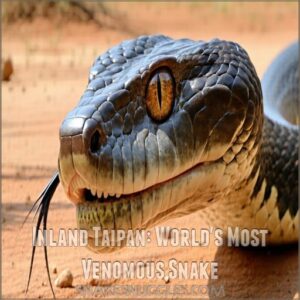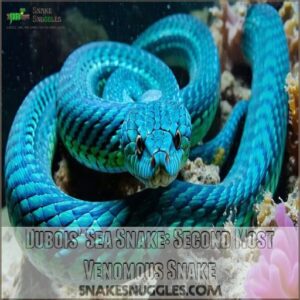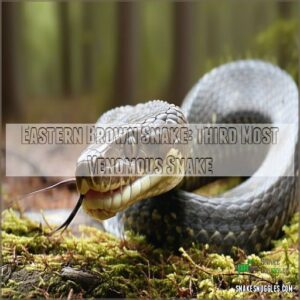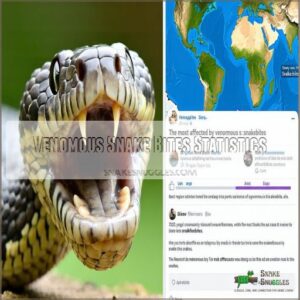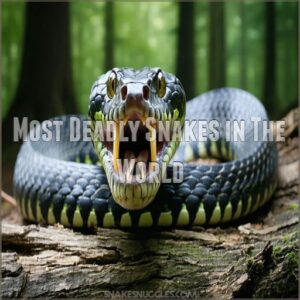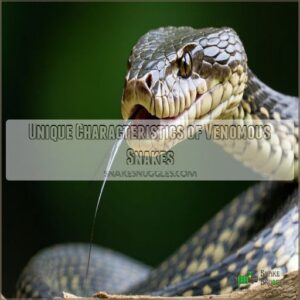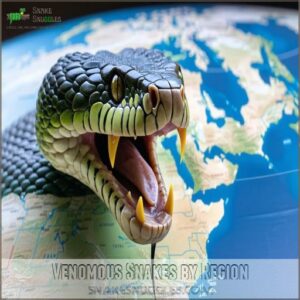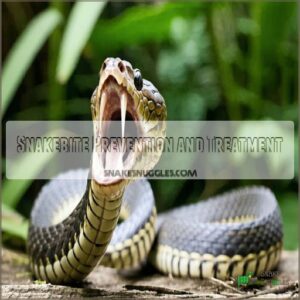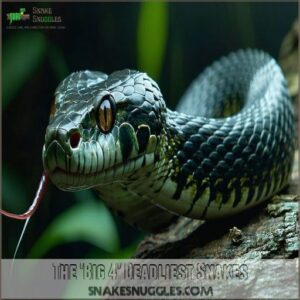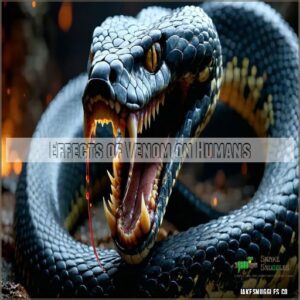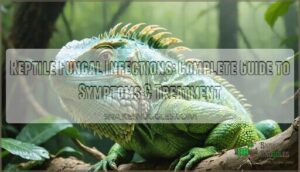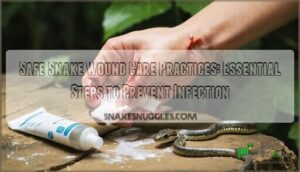This site is supported by our readers. We may earn a commission, at no cost to you, if you purchase through links.
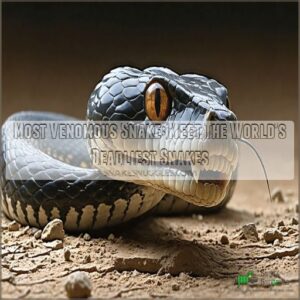 In the realm of "most venomous snake," the inland taipan takes the crown.
In the realm of "most venomous snake," the inland taipan takes the crown.
Also known as the "fierce snake," this Australian native’s venom is as nasty as its reputation.
A single bite has enough potency to knock out a hundred people, thanks to its powerful neurotoxins that swiftly cause paralysis and respiratory failure.
Despite its fearsome name, it’s actually quite the introvert, preferring to avoid humans and stay hidden in the arid outback.
If you ever find yourself in its neck of the woods, knowledge and awareness can be your best defense—more on that to come!
Table Of Contents
- Key Takeaways
- World’s Most Venomous Snakes
- Top 5 Most Poisonous Snakes
- Venomous Snake Bites Statistics
- Most Deadly Snakes in The World
- Unique Characteristics of Venomous Snakes
- Venomous Snakes by Region
- Snakebite Prevention and Treatment
- The ‘Big 4’ Deadliest Snakes
- Effects of Venom on Humans
- Deadly Encounters: Venomous Snakes and Their Victims
- Frequently Asked Questions (FAQs)
- What is the 1 deadliest snake in the world?
- What are the top 3 poisonous snakes?
- Which snake venom kills the fastest?
- What is the most deadly venom in the world?
- What is the world’s largest venomous snake?
- What is a venomous snake?
- What is the most venomous snake in Australia?
- What is the deadliest snake in the world?
- Which snake has the highest venom?
- Are the world’s most venomous snakes real?
- Conclusion
Key Takeaways
- You’ll find the inland taipan, known as the "fierce snake," is the most venomous snake in the world, with venom potent enough to kill 100 people with a single bite.
- Despite its deadly capabilities, the inland taipan is reclusive and prefers to avoid human interaction, residing in the arid regions of central Australia.
- Quick and effective treatment with antivenom is crucial if bitten, as the venom’s neurotoxic effects can lead to paralysis and respiratory failure.
- Understanding these snakes and respecting their natural habitats are key to preventing encounters and promoting safe coexistence.
World’s Most Venomous Snakes
In the fascinating world of venomous snakes, the inland taipan takes the crown with its incredibly potent venom capable of killing 100 humans with a single bite.
Dubois’ sea snake, famed for its oceanic prowess, and the elusive eastern brown snake of Australia, both known for their formidable toxic bites, follow close behind.
Inland Taipan: World’s Most Venomous Snake
Among the world’s deadliest snakes, the inland taipan reigns supreme.
This Australian native holds the title of world’s most venomous snake.
Its venom is incredibly potent; a single bite contains enough venom to kill 100 people!
Here’s what you need to know about this fearsome creature:
- Inland Taipan Habitat: arid and semi-arid regions of central Australia.
- Taipan Venom Effects: neurotoxic and highly toxic, causing paralysis and respiratory failure.
- Taipan Bite Treatment: immediate antivenom is essential.
- Taipan Conservation: efforts focus on habitat protection and reducing human-snake conflict.
Dubois’ Sea Snake: Second Most Venomous Snake
Imagine this: you’re sailing along the tropical coasts, when out in the serene waters lurks the Dubois’ sea snake, the second most venomous snake.
In the event of an encounter, knowing Sea Snake First Aid can be vital.
Its small, aggressive nature and venom, which is a potent cocktail causing paralysis, make encounters risky.
Found in the reefs of Australia, this sea snake’s beauty balances with a deadly mystery, showcasing nature’s unpredictable power.
Eastern Brown Snake: Third Most Venomous Snake
If you’re thrilled by deadly creatures, don’t overlook the eastern brown snake.
It’s right behind the inland taipan in venom potency.
This Australian serpent lands tough punches:
- Habitat: Prefers open forests and grasslands.
- Venom: Neurotoxic venom demands urgent antivenom treatment.
- Bite symptoms: Rapid onset of paralysis and bleeding.
- Safety tip: Never test an Australian snake’s patience!
Top 5 Most Poisonous Snakes
Let’s explore the realm of poisonous snakes, where nature flaunts its most dangerous designs.
Take the inland taipan, a snake whose venom potency is legendary, packing a punch that’s unrivaled.
Then there’s the Dubois’ sea snake, sliding through the waters with a venomous intent that’s second only to the taipan.
The eastern brown snake, equipped with venom that can halt your heart, adds a terrestrial threat.
The inland taipan’s potent venom is a neurotoxin and procoagulant cocktail, making it a highly venomous snake.
Over in Africa, the black mamba dashes with deadly speed, while the king cobra reigns in Southeast Asia, with a bite worthy of a legend.
Curiosity might lead you here, but caution and understanding are your best companions in a world where these reptiles command respect and awe.
Venomous Snake Bites Statistics
When tens of thousands of people encounter snakebites each year, you might be surprised to learn that the majority happen in regions with limited medical access.
These statistics show the global vulnerability and also highlight the economic burden that communities often face due to these incidents.
Number of Snakebites Per Year
In the bewildering world of the world’s most poisonous snakes, snakebite trends reveal startling numbers.
Did you know around 5.4 million snakebites occur yearly, with most of these incidents caused by bites from non-venomous snakes, as identifying venomous vs non-venomous snakes is important for proper treatment.
Here’s how it stacks up:
- Geographic distribution shows most bites in Africa and Asia.
- Seasonal variations increase risks during monsoon.
- Impact on healthcare resources is immense as venomous snakes demand swift intervention.
Mortality Rate From Snakebites
You’re staring at a startling fact: snakebites claim between 81,000 and 138,000 lives each year.
Mortality rates can swing wildly due to factors like antivenom availability and geographical differences.
| Factor | Impact | Note |
|---|---|---|
| Antivenom Access | Reduces fatalities | Essential in remote areas |
| Prompt Treatment | Lower mortality rate | Requires awareness |
| Education | Increases survival chances | Raises snakebite awareness |
| Climate | Affects snake activity | Influences bite frequency |
Understanding these elements can empower communities to tackle this silent killer head-on.
Regions With High Snakebite Incidence
Sadly, many die from snake bites each year. Knowing where these incidents happen most helps us understand the problem. High snakebite rates are seen in specific regions.
- Sub-Saharan Africa faces a high burden due to a combination of factors, including poverty and weak health systems.
- South Asia sees many snakebites due to dense populations and the presence of highly venomous species.
- Latin America also experiences a significant number of snakebites, with geography and climate contributing to the problem.
Economic Impact of Snakebites
Economic Impact: Snakebites hit rural economies hard, driving up healthcare costs. Lack of antivenom access burdens families, altering daily life like a sudden storm.
| Factor | Impact |
|---|---|
| Healthcare Costs | Skyrocketing expenses |
| Rural Economies | Financial strain |
| Antivenom Access | Limited availability |
| Tourism Impact | Wary travelers |
Snakebite prevention programs could be the lifeline here, guiding communities towards resilience.
Most Deadly Snakes in The World
You’re about to learn about the world’s deadliest snakes.
Danger lurks not necessarily in the most venomous bite, but in the frequency of their interactions with people.
With species like the saw-scaled viper and Russell’s viper, these serpents have earned their notorious reputations by being responsible for the highest number of human fatalities.
Saw-scaled Viper: Most Deadly Snake
When snakebite statistics get you curious about deadly predators, consider the saw-scaled viper. This small terrestrial snake, with its quiet, sandy camouflage, is a formidable foe. Here’s why:
- Habitat: Dry regions with plenty of hiding spots.
- Venom: Hemotoxic, causing excessive bleeding.
- Bite: Rapid and aggressive, even without provocation.
- Treatment: Immediate medical attention to counteract its lethal effects.
Russell’s Viper: Second Most Deadly Snake
Imagine crossing paths with the Russell’s viper, a snake notorious for its deadly prowess.
Found across the Indian subcontinent, this viper packs a punch with venom that causes severe bleeding and kidney failure.
Prompt treatment with Russell’s viper antivenom is essential.
To stay safe, learn about its habitat, recognize bite symptoms, and wear protective gear to minimize encounters with this venomous snake.
Indian Cobra: Third Most Deadly Snake
You’ve tackled the Russell’s viper; now meet the Indian cobra, a top challenger in the venomous snakes arena.
This snake’s potent venom can spell trouble in its southern Asian habitat.
Quick reflexes and Indian cobra antivenom are your best allies against bites.
However, Indian Cobra myths sometimes exaggerate its danger.
Still, always approach with caution and respect.
Common Krait: Fourth Most Deadly Snake
The Common Krait, unlike the Indian Cobra, lurks in grasslands and urban areas.
Known for its potent venom, the Krait’s bite can paralyze by sunrise if bitten at night.
Distinguished by its dark body with white bands, this snake’s neurotoxic venom outranks many.
Handle with care and seek immediate treatment—time is essential against this stealthy adversary.
Unique Characteristics of Venomous Snakes
You’ll discover that venomous snakes possess a fascinating array of adaptations, from the boomslang’s unique hunting techniques to the stiletto snake’s impressively long fangs.
These specialized features, coupled with potent venoms, highlight the remarkable diversity and evolutionary success of these reptiles.
Boomslang: Unique Hunting Tactics
After exploring the world’s most deadly snakes, you might be wondering what makes certain species stand out from the rest.
The boomslang, for instance, is a master of ambush and deception.
Like the coral snake’s use of vibrant warning patterns, the boomslang employs mimicry techniques to blend in with its surroundings.
Uses rear fangs to deliver venom to its prey.
Has a highly specialized venom that targets its victim’s nervous system.
Prefers to hunt small mammals, birds, and other reptiles.
Eastern Tiger Snake: Aggressive Behavior
Amidst the rugged landscapes where the Eastern Tiger Snake roams, its aggressive behavior is legendary.
Preferring wetlands and coastlines, it feeds on frogs and small mammals, striking swiftly when provoked.
Conservation efforts are vital for this misunderstood creature, whose potent venom wards off threats yet attracts fascination.
Its bold nature underscores the intricate dance between predator and environment.
| Feature | Eastern Tiger Snake |
|---|---|
| Habitat | Wetlands, Coastlines |
| Diet | Frogs, Small Mammals |
| Defense Mechanisms | Potent Venom |
| Reproduction | Live Births |
| Conservation | Protected Status |
Stiletto Snake: Long Fangs
Imagine crossing paths with the intriguing stiletto snake. Its long fangs, reminiscent of tiny stilettos, come with surprises, striking sideways without even opening its mouth. Found burrowing within sandy soils:
- Unique Features: Stiletto snake’s side-ways stab with fangs
- Hunting Style: Ambushes its prey using stealth
- Venom Potency: Mildly dangerous to humans, yet effective for capturing prey quickly
Understanding these traits can enhance your appreciation of nature’s intricacies.
Beaked Sea Snake: Powerful Venom
The beaked sea snake glides through the waters of South Asia, Australia, and Madagascar, armed with venom that’s among the world’s most potent.
It preys on fish and can incapacitate them in moments.
Despite its power, a beaked sea snake bite doesn’t spell doom for humans if treated promptly.
Curious how such venom evolved?
It’s a masterclass in natural selection!
Venomous Snakes by Region
Now, let’s explore the geographic distribution of these fascinating, yet dangerous, creatures.
You’ll discover which regions boast the most venomous snakes, examining the deadliest species found in Australia, Africa, Asia, and Latin America.
Australia’s Most Venomous Snakes
Australia’s crawling with venomous wonders.
You’ve got the inland taipan, whose venom’s powerful enough to take down a hundred humans.
The eastern brown snake isn’t far behind, packing a punch that’s no joke.
Then there’s the coastal taipan, lurking in northern regions.
Knowing their habitats and respecting their space can boost your snakebite prevention game and help protect these fascinating creatures.
Africa’s Most Venomous Snakes
In Africa, venomous snakes like the black mamba and boomslang command attention.
The black mamba, notorious for its speed and deadly venom, inhabits rocky regions.
Equally compelling, the boomslang uses rear fangs for a unique bite.
Antivenom research continually evolves to combat these threats, emphasizing snakebite prevention in communities vulnerable to these deadly creatures.
African snakebite statistics highlight ongoing challenges.
Asia’s Most Venomous Snakes
Asia’s snakes pack a punch with formidable venom.
Meet the king cobra, renowned for its neurotoxic bite capable of felling even elephants.
The banded krait, a master of paralysis, leaves victims spellbound.
Venom research isn’t just for snakebite treatment but also spurs antivenom development and conservation efforts.
Cultural beliefs highlight the awe and fear these serpents inspire.
Latin America’s Most Venomous Snakes
When exploring Latin America’s most venomous snakes, brace yourself for some fascinating characters.
The Fer-de-lance, also known as Terciopelo, holds the title for causing the most bites.
You’ve got the South American Bushmaster, a massive predator, and the stealthy Coral Snake with its vibrant stripes.
Remember, in terms of snake encounters, here’s a quick guide:
- Be cautious.
- Stay informed.
- Wear protective gear.
- Learn basic venom treatment.
Snakebite Prevention and Treatment
When you’re exploring areas with venomous snakes, wearing sturdy boots and staying alert can prevent unwanted encounters.
Applying first aid immediately and seeking medical help are vital steps to reduce serious complications if you do get bitten.
Precautions When Traveling
Planning a trip to a region with venomous snakes? Smart. Snakebite prevention is key. Here’s a quick guide: Before you head out on your journey, remember that understanding why snakes bite humans, such as in self-defense and territorial aggression, can help you navigate their habitats more safely snake behavior and biting.
| Region | Venomous Snakes | Habitat | Prevention Tips |
|---|---|---|---|
| Australia | Inland Taipan, Eastern Brown | Arid, coastal regions | Avoid tall grass, stay on trails |
| Africa | Black Mamba, Puff Adder | Savannas, woodlands | Be cautious at night |
| Asia | King Cobra, Russell’s Viper | Forests, grasslands | Wear sturdy footwear |
| Latin America | Fer-de-lance, Bushmaster | Tropical rainforests | Stick to marked paths |
| North America | Copperhead, Rattlesnake | Forests, deserts | Check before sitting down |
Remember, awareness is your best defense. Research venomous snake habitats before you go.
Protective Clothing and Footwear
Snakebite protection‘s your shield against mishaps.
Invest in boots for safety to keep snake fangs at bay during hikes or adventures.
Sturdy, snake-proof boots and thick clothing for snakes are your allies.
While trotting through the wild, this hiking gear provides armor against venomous snakes.
Stay vigilant, and these simple steps can turn a potential bite into just an encounter.
First Aid for Snakebites
Just like wearing robust boots isn’t enough to ward off snake venom, you must act swiftly if bitten.
First, identify snake bite symptoms—swelling, discoloration.
Keep calm, immobilize the limb, and seek antivenom administration.
Avoid snake bite first aid myths like cutting the wound.
Mark time and bite location for emergency transport.
Proper care can make all the difference in snake bite outcomes.
Medical Treatment for Snakebites
Imagine the bite stats as a wake-up call, nudging you toward the anti-venom aisle. After a bite, paired with swift first aid, seek professional help.
Here’s your checklist for medical treatment:
- Antivenom development: Ask for the right one.
- Snakebite management: Keep calm, don’t panic.
- Treatment accessibility: Rush to the nearest facility.
- Post-bite complications: Monitor for symptoms.
The ‘Big 4’ Deadliest Snakes
Among nature’s silent killers, the ‘Big 4‘ deadly snakes carve out a fearsome reputation.
The Indian cobra, often lurking in urban landscapes, combines chilling speed with lethal precision, while the common krait serenades the night with its potent venom, leaving muscles powerless.
Across sun-baked terrains, Russell’s viper waits, claiming notoriety with an alarming bite count and dramatic symptoms.
Meanwhile, the saw-scaled viper, with its signature sound—a whispering rustle—remains underestimated, yet deadly.
In the event of a snakebite, purchasing snake antivenom online becomes a critical step in seeking immediate medical treatment.
Their geographic distribution spans bustling cities to remote fields, challenging antivenom availability and stretching healthcare resources.
These serpents, integral yet formidable, remind us of the delicate dance between human inhabitations and wild territories, illuminating the need for awareness and respect in coexistence.
Effects of Venom on Humans
When a venomous snake bites you, it doesn’t just ruin your day; it can seriously harm your body by disrupting critical functions.
Neurotoxic venoms interfere with nerve signals, hemotoxic venoms damage your blood, and cytotoxic venoms destroy cells, ultimately causing severe pain and possibly long-term suffering.
Neurotoxic Venom
A bite from a snake equipped with neurotoxic venom can turn a simple walk into a race against time.
Neurotoxins, often found in the elapidae family, disrupt nerve signals, leading to paralysis and potentially life-threatening conditions.
Understanding these effects aids in developing effective antivenoms.
So, always know your snakes; their venomous nature might just redefine your place in the food chain.
Hemotoxic Venom
Neurotoxic venom attacks your nervous system, causing paralysis.
Hemotoxic venom, however, is a different beast altogether.
It targets your blood, disrupting clotting and causing internal bleeding.
Think of it as a tiny, venomous drain on your body’s resources.
Symptoms can include swelling, bruising, and, in severe cases, organ damage.
Treatment focuses on managing bleeding and supporting your body’s natural healing processes.
Understanding hemotoxins helps you appreciate the intricacies of snake venom toxicity.
Cytotoxic Venom
Cytotoxic venom is a cellular saboteur, breaking down tissues like a wrecking ball. Its hemolytic properties can lead to grisly wounds that require swift attention.
- Rapid swelling: Swift action is essential.
- Tissue necrosis: Parts of your skin might seem to disintegrate.
- Wound complexity: Healing takes time and medical care.
Understanding these effects boosts your control over snakebite risks.
Pain and Suffering
Snakebite pain is no laughing matter.
With venom effects ranging from a burning sting to excruciating agony, the symptoms remind you that a snake’s bite means business.
For those seeking relief from the intense discomfort, products like snakebite pain relief kits can be a helpful resource Snakebite pain relief.
Antivenoms, essential for medical treatment, might save the day, but the psychological impact lingers.
From neurotoxins to cardiotoxins and hemolytic properties, snake venom toxicity can leave a lasting mark on nerves and soul alike.
Deadly Encounters: Venomous Snakes and Their Victims
Ever wonder what makes a venomous snake encounter so perilous? These creatures, armed with potent venom and sharp fangs, often inspire fear.
The inland taipan, considered the world’s deadliest snake, possesses a potent venom capable of killing 50% of test subjects with just 0.025 mg/kg.
Yet, understanding them can be lifesaving. From the swift strike of a blue Malayan coral snake causing paralysis to the aggressive Russell’s viper bringing kidney failure, their encounters are harrowing. Notorious for its necrotizing venom, the fer-de-lance requires immediate treatment to prevent severe damage.
These lethal bites highlight the importance of snakebite prevention—knowing myths, wearing protective gear, and learning snakebite first aid increases survival odds.
Through gripping survival stories and practical tips, gain the upper hand on handling these serpents’ toxic bites and arm yourself with knowledge against snake venom toxicity.
Frequently Asked Questions (FAQs)
What is the 1 deadliest snake in the world?
The inland taipan, nicknamed the "fierce snake," holds the title for deadliest snake.
Its venom can kill 100 men with a single bite, making it a serious contender in the reptile world.
What are the top 3 poisonous snakes?
Forget cuddly kittens; let’s talk venom.
Venom potency doesn’t always equal danger to humans.
You’ll find the inland taipan, eastern brown snake, and Dubois’ sea snake top the list for deadliest venom.
Which snake venom kills the fastest?
Inland taipan venom kills fastest.
It’s the most potent snake venom, working efficiently by paralyzing the victim’s nervous system.
Known as the "fierce snake," it can kill a human in under an hour if untreated.
What is the most deadly venom in the world?
Imagine a venom so potent it can kill 100 adults with one bite.
That’s the inland taipan’s venom, the most lethal globally, capable of causing paralysis and rapid death due to its potent neurotoxins.
What is the world’s largest venomous snake?
The world’s largest venomous snake is the king cobra, reaching up to 18 feet long.
Its powerful neurotoxic venom can take down prey swiftly, yet it uses its size and striking hood to intimidate threats first.
What is a venomous snake?
A venomous snake wields toxins to incapacitate prey or defend itself through specialized fangs.
These potent creatures can inject venom through bites, causing muscle paralysis, pain, or tissue damage.
With caution, coexistence is possible.
What is the most venomous snake in Australia?
You’ve heard it before: Australia is home to the world’s most venomous snake, the inland taipan.
Its venom is so potent it could kill 100 adults with one bite, yet it’s rarely encountered in the wild.
What is the deadliest snake in the world?
Determining the deadliest snake depends on factors beyond venom potency. Consider bite frequency, venom delivery, and access to antivenom. The saw-scaled viper likely claims the most human lives annually.
Which snake has the highest venom?
Inland taipan tops the charts, boasting venom strong enough to drop a hundred adults with a single bite.
This snake’s venom can act faster than a speeding bullet, leaving others in its dust with an LD50 of 025 mg/kg.
Are the world’s most venomous snakes real?
Yes, the world’s most venomous snakes, like the inland taipan and black mamba, are real.
Their potent venoms serve evolutionary roles in predation and defense,
showcasing fascinating adaptations that underscore biodiversity’s complexity and importance.
Conclusion
Picture walking under the blazing sun of the Australian outback, aware of the secrets lurking beneath rocks and shrubs.
The most venomous snake, the inland taipan, shows how powerful and mysterious nature can be.
Despite its lethal bite, it prefers solitude, staying out of human sight.
Understanding these snakes helps you navigate potential danger.
Equipping yourself with knowledge and respect for their habitats can promote a safer coexistence with these fascinating creatures.

